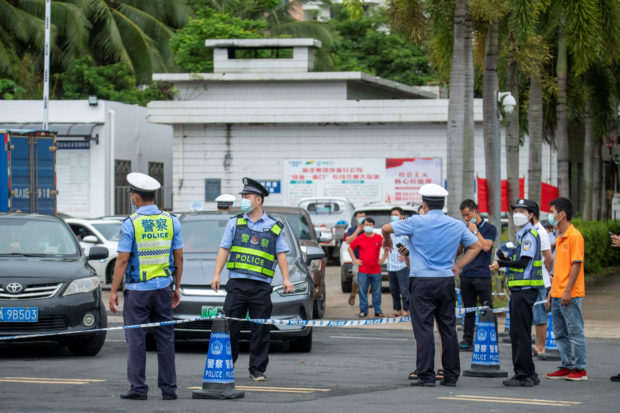
Police officers manage vehicles entering and exiting Qionghai, amid lockdown measures to curb the coronavirus disease (COVID-19) outbreak in Hainan province, China August 7, 2022. cnsphoto via REUTERS
BEIJING/SHANGHAI — China’s Hainan, an island province dependent on tourism, locked down more areas on Monday, state media reported, as it battles its worst COVID-19 outbreak after seeing very few cases in the past two years compared with many other regions in the country.
The province, which recorded just two local symptomatic COVID cases last year, has reported more than 1,500 domestically transmitted infections this month, including over 1,000 symptomatic ones. Although that is low by global standards, it is Hainan’s biggest outbreak since the virus was first reported in the central Chinese city of Wuhan in late 2019.
The sharp increase in cases comes as interest in tourism picks up after China slightly eased curbs aimed at domestic travel, accounting for the shorter quarantine time facilitated by the shorter incubation period of the Omicron variant.
However, the curbs in Hainan, in line with China’s “dynamic COVID-zero” policy that aims to stamp out outbreaks as soon as possible, point to persistent uncertainty shrouding travel and may further dampen confidence in the tourism and hospitality sectors.
The provincial capital city of Haikou, home to about 2.9 million people, and three smaller towns, Wuzhishan, Ledong and Chengmai, locked down residents on Monday, according to state media reports.
Police officers manage vehicles entering and exiting Qionghai, amid lockdown measures to curb the coronavirus disease (COVID-19) outbreak in Hainan province, China August 7, 2022. cnsphoto via REUTERS
At least nine cities and towns, with a combined population of about 7 million, said their residents must not leave where they live except for necessary reasons such as COVID tests, grocery shopping or essential job roles. They also suspended public transport services.
The measures will stay in place for varying periods, with the shortest scheduled for just a few hours on Monday, in Haikou, state media reports show.
About 25,000 tourists were stranded in Sanya, the hardest-hit city in Hainan’s outbreak and the tropical island’s key tourist hub, as of Sunday. Although cities have said tourists can leave after COVID tests, many were frustrated about the disruption.
“We’ve had four flights canceled. Our new one is on Sunday, hopefully,” said Kyle, a 28-year-old teacher, whose first attempt to take a holiday after 2.5 years in China has left him stuck in Sanya, where people were lining up in the rain for COVID tests on Monday.
“If you’re travelling in general in China, you should kind of be aware of what could happen. If you don’t consider that, then you should probably just not go in the first place,” he told Reuters.
In Qionghai city, scheduled to be locked down for three days, all flights at Qionghai Boao Airport scheduled for Monday were cancelled for “public security reasons”.
A courier stands on an electric bike to make a delivery over a barricade, amid lockdown measures to curb the coronavirus disease (COVID-19) outbreak in Sanya, Hainan province, China August 6, 2022. China Daily via REUTERS
Shares fall
Chinese stocks in tourism, transport and consumer staples all retreated on Monday, with China Tourism Group Duty Free Corp down 4.7%. Sanya began closing duty-free malls last week.
The lockdowns also dashed hopes for a quick rebound for the country’s ailing aviation sector, which had counted on a summer travel boom to help trim record losses.
Hainan Airlines shares fell 1.5% on Monday, hovering around the lowest level since February last year, when the airline was in the midst of a restructuring to settle a multi-year liquidity crisis.
The airline said in July that its first half net loss is expected to expand to 11.95-12.96 billion yuan ($1.77 billion-$1.92 billion) from 880.9 million yuan a year earlier.
Nationwide, China reported 807 locally transmitted COVID infections for Aug. 7, of which 324 were symptomatic and 483 were asymptomatic, the National Health Commission said.
There were no new deaths, keeping the nation’s fatalities unchanged at 5,226.
As of Sunday, mainland China had confirmed 231,266 cases with symptoms, including both local patients and symptomatic international travellers.
China’s capital, Beijing, reported two new local symptomatic cases for Aug. 7, while Shanghai and the southern technology hub of Shenzhen reported no new local cases.
($1 = 6.7633 yuan)
RELATED STORIES
COVID-19 lockdown turns Chinese tourist hotspot Sanya into nightmare for stranded tourists
Over 80,000 tourists trapped in ‘China’s Hawaii’ after COVID-19 outbreak
Hainan projected to be new gateway for China-Asean trade
China plans to turn Spratlys into tourist destination